A chimeric yellow fever-Zika virus vaccine candidate fully protects against yellow fever virus infection in mice
- PMID: 32116148
- PMCID: PMC7067203
- DOI: 10.1080/22221751.2020.1730709
A chimeric yellow fever-Zika virus vaccine candidate fully protects against yellow fever virus infection in mice
Abstract
The recent Zika virus (ZIKV) epidemic in the Americas, followed by the yellow fever virus (YFV) outbreaks in Angola and Brazil highlight the urgent need for safe and efficient vaccines against the ZIKV as well as much greater production capacity for the YFV-17D vaccine. Given that the ZIKV and the YFV are largely prevalent in the same geographical areas, vaccines that would provide dual protection against both pathogens may obviously offer a significant benefit. We have recently engineered a chimeric vaccine candidate (YF-ZIKprM/E) by swapping the sequences encoding the YFV-17D surface glycoproteins prM/E by the corresponding sequences of the ZIKV. A single vaccine dose of YF-ZIKprM/E conferred complete protection against a lethal challenge with wild-type ZIKV strains. Surprisingly, this vaccine candidate also efficiently protected against lethal YFV challenge in various mouse models. We demonstrate that CD8+ but not CD4+ T cells, nor ZIKV neutralizing antibodies are required to confer protection against YFV. The chimeric YF-ZIKprM/E vaccine may thus be considered as a dual vaccine candidate efficiently protecting mice against both the ZIKV and the YFV, and this following a single dose immunization. Our finding may be particularly important in the rational design of vaccination strategies against flaviviruses, in particular in areas where YFV and ZIKV co-circulate.
Keywords: CD8+ T cells; YFV-17D; chimeric flavivirus vaccine; live-attenuated vaccines; non-neutralizing antibodies.
Conflict of interest statement
D.B.K, N.M, J.N. and K.D have filed a patent application claiming the discovery and use of chimeric yellow fever-Zika virus vaccines.
Figures
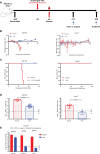
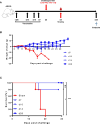
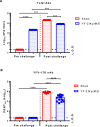

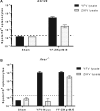

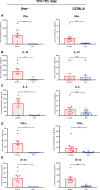
Similar articles
-
A Chimeric Japanese Encephalitis Vaccine Protects against Lethal Yellow Fever Virus Infection without Inducing Neutralizing Antibodies.mBio. 2020 Apr 7;11(2):e02494-19. doi: 10.1128/mBio.02494-19. mBio. 2020. PMID: 32265332 Free PMC article.
-
A bivalent self-amplifying RNA vaccine against yellow fever and Zika viruses.Front Immunol. 2025 Apr 29;16:1569454. doi: 10.3389/fimmu.2025.1569454. eCollection 2025. Front Immunol. 2025. PMID: 40364846 Free PMC article.
-
Yellow fever vaccine protects mice against Zika virus infection.PLoS Negl Trop Dis. 2021 Nov 4;15(11):e0009907. doi: 10.1371/journal.pntd.0009907. eCollection 2021 Nov. PLoS Negl Trop Dis. 2021. PMID: 34735450 Free PMC article.
-
T Cell-Mediated Immunity towards Yellow Fever Virus and Useful Animal Models.Viruses. 2017 Apr 11;9(4):77. doi: 10.3390/v9040077. Viruses. 2017. PMID: 28398253 Free PMC article. Review.
-
Yellow Fever Virus: Knowledge Gaps Impeding the Fight Against an Old Foe.Trends Microbiol. 2018 Nov;26(11):913-928. doi: 10.1016/j.tim.2018.05.012. Epub 2018 Jun 19. Trends Microbiol. 2018. PMID: 29933925 Free PMC article. Review.
Cited by
-
A novel therapeutic HBV vaccine candidate induces strong polyfunctional cytotoxic T cell responses in mice.JHEP Rep. 2021 Apr 22;3(4):100295. doi: 10.1016/j.jhepr.2021.100295. eCollection 2021 Aug. JHEP Rep. 2021. PMID: 34159304 Free PMC article.
-
Zika Virus-A Reemerging Neurotropic Arbovirus Associated with Adverse Pregnancy Outcomes and Neuropathogenesis.Pathogens. 2024 Feb 15;13(2):177. doi: 10.3390/pathogens13020177. Pathogens. 2024. PMID: 38392915 Free PMC article. Review.
-
Parallel Multifactorial Process Optimization and Intensification for High-Yield Production of Live YF17D-Vectored Zika Vaccine.Vaccines (Basel). 2024 Jul 9;12(7):755. doi: 10.3390/vaccines12070755. Vaccines (Basel). 2024. PMID: 39066393 Free PMC article.
-
The Chimeric Chaoyang-Zika Vaccine Candidate Is Safe and Protective in Mice.Vaccines (Basel). 2024 Feb 19;12(2):215. doi: 10.3390/vaccines12020215. Vaccines (Basel). 2024. PMID: 38400198 Free PMC article.
-
Novel approaches for the rapid development of rationally designed arbovirus vaccines.One Health. 2023 May 13;16:100565. doi: 10.1016/j.onehlt.2023.100565. eCollection 2023 Jun. One Health. 2023. PMID: 37363258 Free PMC article.
References
MeSH terms
Substances
LinkOut - more resources
Full Text Sources
Other Literature Sources
Medical
Research Materials
